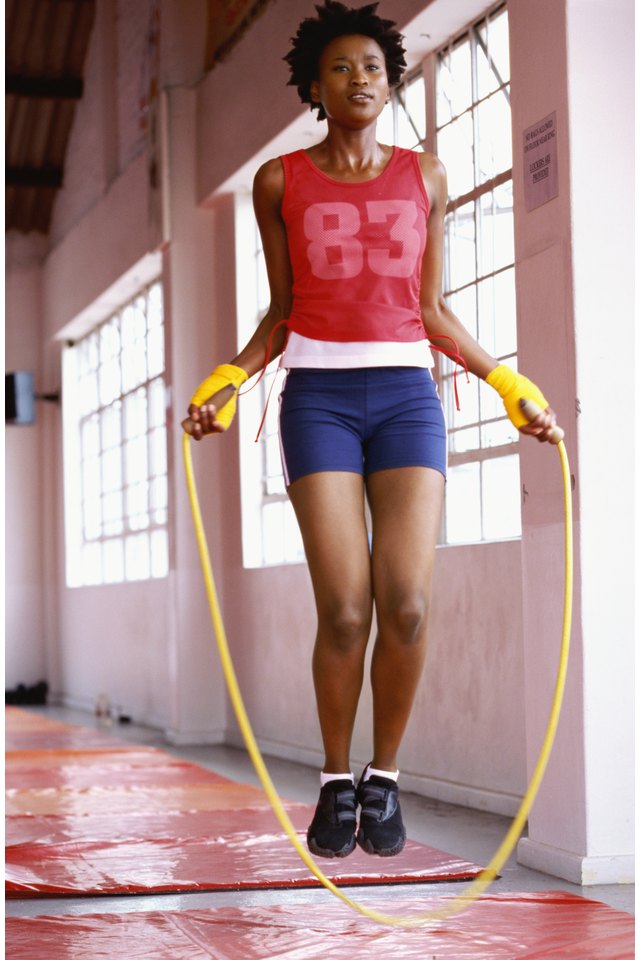Does Jumping Rope Help With Sprinting?

Your sprint speed is the result of the intensity of your training program and genetics. Those with less than optimal athletic genes may be fast sprinters with the proper training. In addition to helping with strength training and sprint training, jumping rope may also help improve your sprint speed. Incorporate it into your training program to shave time off your sprint speed.
Plyometric Training
A plyometric exercise is one in which you pre-load your muscles before contracting them to generate a stronger force. In rope jumping, for example, a slight bend is in your knees and ankles before you jump. If you are performing double-jumps, a more significant bend is in your legs to produce a larger force to help you jump higher. Performing plyometric exercises, such as jumping rope, may help improve your sprint speed.
Effects of Plyometric Exercise on Sprint Speed
Researchers in the School of Physical Education at The University of Otago in New Zealand designed a study to determine the effects of plyometric exercise, such as jumping rope, on sprint performance. In the study, 26 males participated in 15 plyometric training sessions over an eight-week period. When compared to a control group, the men in the plyometric training group had significant improvements in 10-meter and 40-meter dash times. Researchers concluded that a decrease in ground contact time may be the reason why sprint times improved.
Effect of Jumping Rope on Young Athletes
Han-Long Lin published a master's thesis in 2009 citing the effects of jumping rope on young track and field players. The athletes were divided into two groups. The first group completed a 12-week jump rope program three times per week during practice. The second group performed routine track exercises. Lin noted a significant decrease in 10-meter and 60-meter sprint times in the group that jumped rope. Therefore, jumping rope likely improves sprint speed in young athletes.
Recommendations
Diversifying your sprint-training program to include other high-intensity, fast-paced exercises, such as jumping rope, may improve your sprint speed. In addition to jumping rope, you may also want to include other types of plyometric exercises into your program. Continue your current sprint-training program, but include plyometric exercises into your workouts at least three times per week to improve your speed. Check your sprint time regularly to make sure the changes in your workout are beneficial to your performance.
References
- Trecroci A, Cavaggioni L, Caccia R, Alberti G. Jump Rope Training: Balance and Motor Coordination in Preadolescent Soccer Players. J Sports Sci Med. 2015;14(4):792-798.
- Baumgartner L, Weberruß H, Oberhoffer-fritz R, Schulz T. Vascular Structure and Function in Children and Adolescents: What Impact Do Physical Activity, Health-Related Physical Fitness, and Exercise Have? Front Pediatr. 2020;8:103. doi:10.3389/fped.2020.00103
- Ozer D, Duzgun I, Baltaci G, Karacan S, Colakoglu F. The effects of rope or weighted rope jump training on strength, coordination and proprioception in adolescent female volleyball players. J Sports Med Phys Fitness. 2011;51(2):211-219.
- Van Hooren B, Peake JM. Do We Need a Cool-Down After Exercise? A Narrative Review of the Psychophysiological Effects and the Effects on Performance, Injuries and the Long-Term Adaptive Response. Sports Med. 2018;48(7):1575-1595. doi:10.1007/s40279-018-0916-2
Writer Bio
As a physical medicine and rehabilitation physician I have extensive experience in musculoskeletal/neurological medicine that will benefit the network.
